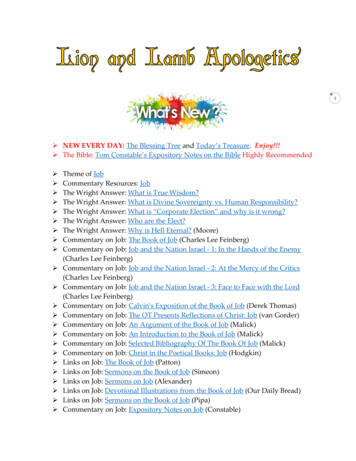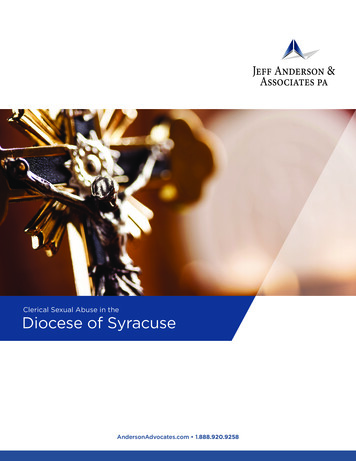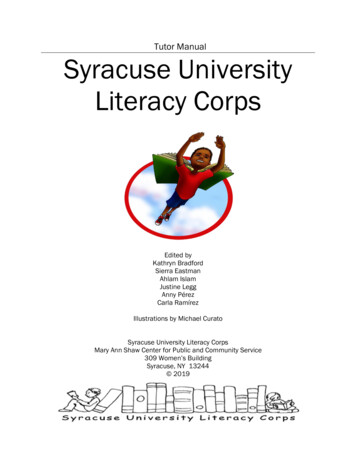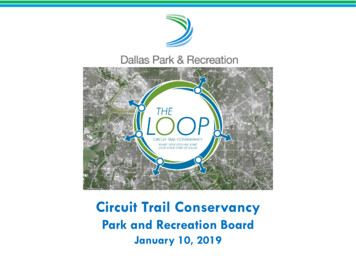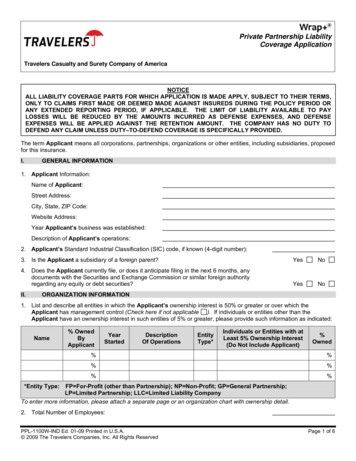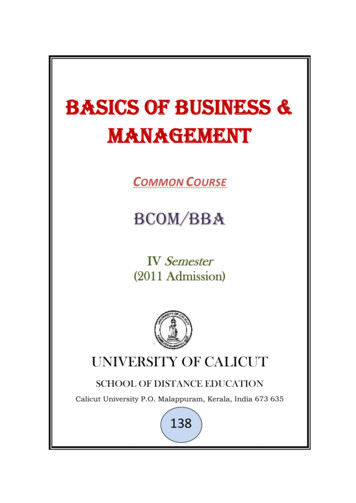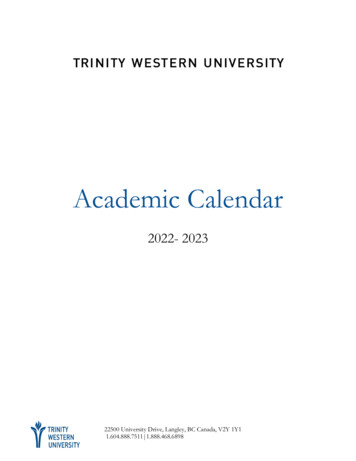
Transcription
Transforming Communities InitiativeSyracuse, Syracuse, NYFunded by Trinity Health, the four-year Transforming Communities Initiative (TCI) supported eightcommunities to build capacity for — and successfully implement — policy, system, and environmental (PSE)change strategies. Each collaboration — involving a lead community organization with a full-time TCI-fundedprogram director, the local Trinity Health hospital, and other partners — received grant funding and technicalassistance and participated in peer learning opportunities. This site profile, prepared by the cross-siteevaluation team at the Georgia Health Policy Center in partnership with the local partners, outlines the workand impact supported by TCI between 2016 and 2020.The PartnershipSyracuse PartnersTCI Syracuse was formed after Trinity Health’sannouncement of their Transforming CommunitiesInitiative (TCI). A group of key organizations cametogether to work on a shared mission, vision, andcollective set of goals and projects aimed at benefitingcity residents. By influencing policy, systems, andenvironmental changes, TCI Syracuse envisions anengaged, invested, and collaborative communityin which residents, local businesses, and otherorganizations work together to create and sustain ahealthy community through healthy eating and activeliving initiatives. St. Joseph’s Health Northside Urban Partnership Onondaga County Health Department Tobacco Action Coalition of OnondagaCountyCenterState Corporation for EconomicOpportunityHealtheConnectionsLerner Center for Public Health Promotion atthe Maxwell School at Syracuse UniversityNear Westside InitiativePeacemaking Center’s Community ImpactTeamTCI Syracuse focuses on the city of Syracuse,specifically on the Near Westside and Northsideneighborhoods, where there are high socioeconomic needsthat correlate with poor health outcomes. As a Designated RefugeeResettlement Community, many refugees are relocated in the Northsideneighborhood. These two neighborhoods have a population of 74,827and have a very different racial and income breakdown compared tothe county. The population is 58% white, 22% Black, and 7% Asian, and11.5% of the population identifies as Hispanic or Latino.“I think the greatest successis the fact that we were ableto form an actual coalition, afunctional group of partners whowere excited and ready to workmore collaboratively.”The backbone responsibilities for this collaborative have been splitbetween CenterState CEO and St. Joseph’s Health (SJH), with CenterState CEO housing the program directorand St. Joseph’s Health serving as the fiscal agent and providing project oversight.ApproachTCI Syracuse was formed at the beginning of TCIand, in many ways, was shaped by the TCI grantstructure. As the partners worked together toaccomplish the TCI grant objectives and build asuccessful coalition, they evolved from a groupof independent organizations to a more cohesiveunit, creating an opportunity to leverage theircollective strength to pursue a more health equity–focused agenda for future efforts. TCI Syracuse issued subawards to partnerorganizations with 51% of funds. TCI Syracuse tracked more than 4.25 millionin matching funds, including local commerce andbusiness organizations, public health, communitybased organizations, academic institutions, andfoundations. TCI Syracuse used about 20% of their TCI funds tosupport their program director.1
TCI Syracuse was able to stretch the resourcesof TCI by aligning complementary work amongpartners across a number of strategies in a broadapproach to community transformation in twohigh-needs neighborhoods over four years inSyracuse: the Near Westside and Northsideneighborhoods.“We were able to focus on resident leadershipdevelopment and advocacy, whether it was through theNear Westside, or the approach that Northside UP tookwith a human center design work around the women’swellness space and having the women in the communitybe there every step of the way, from start to finish.”TCI Syracuse engaged TCI technical assistancestrategically and worked most closely with Community Catalyst for coalition-building and strengtheningcommunity engagement efforts. A notable impact of TCI Several stakeholders discussed the positiveinfluence these deeper relationships had on the work through staff and leadership transitions andsustainability planning. Community engagement became a cornerstone to TCI Syracuse’s communitytransformation approach, which has been credited for building trusting relationships between TCI partnerorganizations and the Near Westside and Northside neighborhoods that will support the sustainability ofcurrent work and increase the possibility of future transformation efforts.Areas of Impact“I think that is something that we were able to dothrough TCI, start to be a little bit more innovative andshow people that you can do things differently.”Most of TCI Syracuse’s strategies continued fromYear 1 to Year 4, with two new strategies beginningin Year 4 (food policy council work and participatory budgeting). TCI played a supportive role in each of thesestrategies — providing expertise, funding, visibility, and other resources that allowed local organizations toimplement the strategies. As one of two communities to host a Learning Institute, TCI Syracuse was able toshare their community work with seven other TCI sites.DomainYearsProgress and Outcomes Influenced By TCI-Supported Work1–4A Tobacco 21 policy was passed in Onondaga County effective2017, and the New York statewide Tobacco 21 policy becameeffective in November 2019.Estimated reach: 19,363 students1–410 schools engaged, wellness committees formed at eight schools,installed (or are in the process of installing) walking trails at sevenschools, and pop-up play events and active toy check-out engageresidents in communities.Estimated reach: 5,937 students1– 4Worked with five schools. City of Syracuse plans to formally studySafe Routes to School and change systems to facilitate futureprojects.Estimated reach: 705 studentsTobaccoPreventionEarly Care andEducationPublic SchoolWellness Policy2
DomainYears1– 4Facilitated the development of 2 community spaces that encouragephysical activity — Women’s Wellness Center and PerformancePark, funded by 1.35 million in private funding.Estimated reach: 29,006 residents1– 412 corner stores engaged to offer and promote healthy options; 1mural to promote healthy food painted outside a corner store.Estimated reach: 96,179 residents, including 3,548 students3–427 breastfeeding rooms were created throughout the community inorganizations and community spaces, and a successful social mediacampaign to normalize breastfeeding was run, with 2 organizationsadopted breastfeeding policies.Estimated reach: 12,038 women4–4Convened stakeholders and supported the establishment of theSyracuse-Onondaga County food policy council, developed awebsite, and created and maintained a map of emergency fooddistribution sitesEstimated reach: 464,140 Onondaga County residents4– 4Held 8 meetings to engage community stakeholders and residentsinterested in a participatory budgeting process to find alignmentfor current and future work.Built EnvironmentCommunity FoodAccess CornerStore InitiativeBreastfeedingFood Policy CouncilParticipatoryBudgetingProgress and Outcomes Influenced By TCI-Supported WorkStrong Tobacco-Free Policies at the Local County and State LevelTCI Syracuse’s tobacco efforts from the beginning focused on passing Tobacco 21 legislation at the countyand state levels and reducing advertising and sales of tobacco products to minors. TCI Syracuse supportedthe reconstitution of the Tobacco Action Coalition of Onondaga (TACO) as the primary partner addressingtobacco policy, which incorporated strengthening the coalition, community outreach and education,communications and social media campaigns, and communicating with elected officials and decision-makers.This work was described as somewhat likely to have occurred without the support of TCI, including programdirector support, funding, and technical assistance. During TCI, TCI Syracuse: Developed targeted messaging to county legislators that included educational mailings and packets,in-person meetings, presentations at public hearings, letters to the editor, letters of support fromlocal organizations, and two public service announcements that aired in November and December3
2017. Local media picked up on the campaign and published 32 earned media articles. Thecampaign successfully convinced lawmakers not to include a military exemption and changed threelegislators’ votes from no to yes to pass Tobacco 21, which went into effect in January 2018. Assisted TACO in their Point of Sale initiative, where they geocoded and generated maps of tobaccoretailers within 1,000 feet of a school, hospital, or library. These maps were presented to the Point ofSale coalition to inform their policy work. TCI Syracuse also partnered with the Lerner Center of Public Health Promotion on an observationalstudy of all Syracuse City School District (SCSD) properties. In all, 36 buildings were observed inApril 2019. The study demonstrated that 69% of TCI-area school locations were missing tobaccofree signage. As a result, TCI Syracuse purchased 490 tobacco-free signs for all SCSD buildings.Signs included comprehensive messaging around all forms of tobacco use, including vaping, and areavailable in Spanish.Nutrition Policies and Practices in Early Care and EducationEnhancing nutrition policies and practices in Early“[TCI Syracuse] touched on so many different thingsCare and Education settings focused on site-bywith so many of our partners, like working on nutritionsite nutrition policy adoption and implementationpolicies. Every time you get another organization in toamong childcare centers. TCI Syracuse workedadopt a policy, there’s another one right behind it thatclosely with the Onondaga County Healthyou’re working with.”Department (OCHD) to build relationships withcenters by providing assessments; training onbest practices and policies on nutrition standards,mealtime practices, and nutrition education; and technical assistance (TA) in implementation. During TCI, TCISyracuse: Provided training on best practices, policies, andprocurement, with three centers implementing writtennutrition policies Provided support to centers in the form of TA and minigrants Evaluated each site using a standardized assessment (GONAPSACC) conducted at baseline and annually, whichshowed all centers implementing more nutrition bestpractices over time Installed a teaching garden Observed 78% of centers improve nutrition best practices“Development of acomprehensive health andwellness policy to supportbest practice and systematicimplementation of associatedactivities is time well spent inthat it provides an opportunity toenhance the quality of servicesprovided to children and families.”Wellness Policy and Physical Activity Guidelines inSyracuse City School DistrictAs the primary TCI partner working on school wellness, OCHD focused on increasing the number of physicalactivity best practices implemented at priority schools through environmental and practice changes. TCISyracuse’s school wellness work included surveys and assessments, engaging district and school staff toimprove infrastructure, and implementing and strengthening a pre-existing school wellness policy. During TCI,TCI Syracuse:4 Conducted surveys and building assessments, which were used to inform school-level strategies anddevelop action plans Engaged teachers and wellness champions and formed wellness committees Built capacity in schools by providing training, TA, and minigrants
Provided the WellSAT report to the district wellness committee to support strengthening districtwellness policy language, which the district adopted in May 2019 Supported environmental changes (playground, climbing wall, indoor walking trail, school farmers’markets)Safe Routes to School PrinciplesThe OCHD and HealtheConnections worked with the City of Syracuse Department of Planning andDepartment of Public Works to implement Safe Routes to School principles by engaging parents andteachers, auditing and mapping routes, purchasing equipment, and increasing signage. During TCI, TCISyracuse: Conducted best practice research, parental surveys, and walkability assessments and audits Held educational meetings with school leadership, teachers, and parents Purchased bike racks and locks Collected baseline active transit data, mapped route networks, and observed pilot routes for use; Designed, identified placement for, and installed signs along two pilot safe routes, with two schoolslaunching safer routes and three more schools installing signs in 2020 Facilitated systems change in the city of Syracuse to formally study and facilitate Safe Routes toSchoolMultigenerational Wellness SpacesTCI Syracuse’s work to improve the built environment focused on creating multigenerational wellness spacesthat will provide access to physical activity and nutrition resources in the Near Westside and Northsidecommunities by engaging residents in the design and program planning for the Northside Wellness Space (inthe Northside community), Performance Park (in the Near Westside community), and activating vacant parksand public spaces through pop-up play events. During TCI, TCI Syracuse: Hosted nine pop-up play events that reachednearly 350 adults and children in the NearWestside Engaged the Near Westside and Northsidecommunities in design and planning activities Commissioned an architectural design and anAlternative Markets study to establish feasibility,demand, and scope of work Developed conceptual plans based oncommunity input and feedback gatheredthrough prototyping activities and interviewswith key stakeholders Managed the permitting and construction of Performance Park and the Northside Wellness Space,with construction completed on Performance Park Planned for the sustainability of the Northside Wellness Space by securing funding to build thespace out and cover costs for three years and establishing the YMCA as the operator and serviceproviderOver four years, TCI Syracuse worked to securefunding for, engage residents about, design,and move through permitting and constructiontwo spaces in the community: NorthsideWellness Space (in the Northside community)and Performance Park (in the Near Westsidecommunity). Both spaces did not exsist beforeTCI and will provide much-needed access tophysical activity in the community at no, orlittle, cost to residents.5
Environmental Changes and Policies to Support BreastfeedingAs the primary TCI partner working to create environmental changes and policies to support breastfeeding,OCHD focused on partnering with community-based organizations, health care facilities, county offices,childcare centers, and others to normalize breastfeeding, provide breastfeeding-friendly rooms, and supportthe adoption of breastfeeding-friendly policies. During TCI, TCI Syracuse: Purchased and installed equipment, furniture, and signage to establish breastfeeding rooms Conducted post-construction and annual assessments Launched a marketing campaign to reinforce messaging around the importance and normalizationof breastfeeding, which made 289,958 impressions and received 974 ad clicks, linking to the Centersfor Disease Control and Prevention’s page on breastfeeding information Supported the adoption of breastfeeding-friendly policiesAccess to Healthy FoodsTCI Syracuse worked to increase access to healthy foods byfocusing on procurement, placement, and advertising for healthyfood in corner stores located in ZIP codes 13203, 13204, 13206,and 13208. During TCI, TCI Syracuse: Conducted store assessments and examined the capacityfor selling and storing fresh, healthy foods, signage, andinterest in changing procurement and sales practices — Assessments show five (out of nine) stores sellingmore healthy products than unhealthy productsnear the checkout counter More stores began displaying healthy ads andselling healthy foods“[Long-term] I see policies that helpsupport a local food economy, andhelp address some of the food desertareas in the community. I see thefarmers thriving, and not starving, inour more rural areas of the county. [Isee] people coordinating better andcollaborating with important playersin our legislature, and different levelsof government, in a way that hasn’tbeen done here before.” Provided support to corner stores in the form of minigrants, TA related to best practices, and publicpromotion of their efforts Supported the adoption of healthy corner store policies Piloted a produce delivery program in partnership with a local pharmacy Partnered with one store and a nearby elementary school to paint a mural of healthy foods on theside of the store Observed that stores receiving TA as part of the program showed an increase in the produceavailable, healthier ads, and healthier foods near the checkout counterIn addition to the healthy corner store initiative described above, TCI Syracuse participated in the creation ofa local food policy council, the Syracuse-Onondaga Food Systems Alliance (SOFSA), to address food systemsissues during the final year of the TCI grant. In response to a series of local convenings around food and foodsystems issues, during which many community stakeholders expressed interest in exploring the formationa council to address multisector challenges in the food space, HealtheConnections hired a consultant fromJohns Hopkins Center for a Livable Future to assess the local landscape and capacity for a council and provideTA and recommendations for next steps.6
A local facilitator will continue this work by coordinating partners and meetings and exploring the structureand sustainability of a food policy council that aims to address local issues related to food production, access,distribution, and nutritional health in Onondaga County. Before the end of TCI, six organizations had providedformal letters of support for SOFSA.Design and Use a Participatory Budgeting ProcessCommunity residents are often excluded from giving inputParticipatory budgeting is a democratic processand making decisions around how policies and resourceswhere community members make decisionsare invested in their neighborhoods, particularly aroundon how public funds are spent. Communitysocial influencers of health. In Year 4, TCI Syracuse beganmembers brainstorm ideas, develop proposals,designing a participatory budgeting (PB) process in whichvote, and fund the winning projects.community members would participate in decisions abouthow to spend funds to address a community need. ThePB workgroup includes TCI Syracuse, St. Joseph’s Hospital,local philanthropies, the city of Syracuse (certain departments), and other key community stakeholders, andthey are working on connecting with other groups interested in this process (e.g., the school district). PB is ademocratic process where community members make decisions on how part of a public budget is spent. Atypical PB cycle takes a year and involves community engagement in designing the process, brainstormingideas, developing proposals, voting, and funding and implementing the winning projects. During the finalyear for TCI, TCI Syracuse: Convened a group of local leaders to share thatTCI Syracuse was interested in making a smallinvestment in seeding a PB projectHired a consultant to complete a landscapeanalysis of the current community organizinginfrastructure in the Near Westside and Northsideneighborhoods, receiving the final report in May2019“I think that the work that TCI expanded into inYear 4 was among the most valuable activitiesand they weren’t part of the original work plan.So I, I love that they did that.”COVID-19The COVID-19 pandemic slowed down or halted many of TCI Syracuse’s projects. While they were able tostrategically reallocate resources to advance some pre-existing efforts, with the potential for immediate andlong-term impacts (i.e., SOFSA), others, like the implementation of PB, remained in limbo based on thenature of the process and heavy reliance on in-person activities. Some projects, like those related to work inthe schools, were close enough to completion for the year that implementation efforts were not as negativelyimpacted by closures as the evaluation was. A key difference in the status of PB, however, was that the projectwas already running six months behind due to delays in the contracting process between the hospital and thepartner organization leading the facilitation. This was a main barrier in advancing the project to a point closeto completion by the time they had to pause and reassess due to COVID-19. Since they reached the stage ofidea generation and collection before the impact of the pandemic, they will likely repeat/refresh this stage toinclude project ideas that consider the community’s needs in a post-COVID environment.7
Key Insights From TCITCI Syracuse created a network of partners that ultimately helped influence policy and practices within thecommunity while navigating the local political and social landscape. By including organizations across thespectrum from grassroots to grasstops, TCI ensured that residents’ voices would be heard by key decisionmakers and stakeholders in various systems.During the course of TCI, the TCI Syracuse team learned to adapt and make necessary modifications to theirwork based on community needs and feedback, evaluation, and unexpected challenges. While navigating anoften-nonlinear process, some key takeaways were: The value of a human-centered design approach to projects — identifying and engaging communitychampions to help drive the work and creating a strong feedback loop. The value of planning and the importance of setting expectations on all sides — emergingcommunity needs did not always align with the scope of work partners had been funded toaccomplish. When there are not clear expectations, restrictions in the programmatic focus area andscope of work vs. balancing the importance of addressing real-time community needs can be achallenge with limited resources. Projects take time because it is imperative that we move at the “speed of trust.” Meaningfulcommunity engagement and resident buy-in can be a long and nuanced process. Empowering residents to lead the work is critical for long-term sustainability. Investing in the peopleand providing them with resources to work alongside service providers promotes more effective andauthentic engagement. More hands are needed to make the work light. Kitchen table talks, smallinformal gatherings at community members’ homes, and similar activities are helpful for engagingand meeting people where they are. Diverse, and at times unconventional, partnerships can be powerful. Identifying opportunities for,and improving, communication among organizations doing similar work and leveraging resourcescan lead to a larger collective impact in the community.Looking AheadTCI Syracuse engaged local consultants in their sustainability planning process, which reviewed TCI Syracuse’sorigin, vision and mission, history, and opportunities to continue the community-based public health workbeyond TCI funding. The purpose of this process was to create a mission model, strategy, and road mapfor TCI to move forward. The planning process engaged TCI Syracuse’s program director and partners andincluded a review of TCI Syracuse’s project portfolio, current funding opportunities, and comparable healthcare collaboratives.In this process, TCI Syracuse established that a health equity focus, neutral backbone organization, targetfunding, and the program director’s expertise were all priorities in the future of TCI Syracuse. With severalvalue propositions and sustainability scenarios proposed, TCI Syracuse was poised to begin to explore thefeasibility of identified sustainability options when TCI was transformed to focus on COVID-19 relief.The sustainability work of the coalition in Year 4 also included coalition members actively pursuingopportunities to partner with other initiatives to leverage collective resources and expand positive impact inthe community, while also working to establish and legitimize new collaboratives focused on specific systemschange (i.e., SOFSA). While many TCI projects are embedded in partner organizations and will likely continuewithout the formal TCI structure, the path to sustainability for the participatory budgeting process and TACOare not as clearly defined as they are not embedded in any partner organization or funded by external grants.8
About the Transforming Communities InitiativeTrinity Health launched the Transforming Communities Initiative (TCI) in 2016 to provide grant fundingand technical assistance to hospital-community partnerships. Between July 2016 and June 2020, thesepartnerships worked on a range of initiatives including tobacco prevention and reduction, public schoolwellness, early care centers’ policies and practices, community food access and nutrition, built environmentpolicies and infrastructure to improve walkability and safety (Complete Streets), breastfeeding policies, andeconomic development. Partnerships also built community capacity and strengthened local coalitions.TCI technical assistance was provided by ChangeLab Solutions, Community Catalyst, Public Good Projects,Campaign for Tobacco Free Kids, and the Georgia Health Policy Center (GHPC).GHPC — in close collaboration with local evaluators — conducted the TCI cross-site evaluation to assesspartnership development and collaboration, as well as policy, systems, and environmental change reach,implementation, and impact. Data sources included key stakeholder interviews, TCI partner collaborationsurveys, and project documents including site annual reports, meeting notes, site visits, and observations.Quotations in this profile are from stakeholder interviews and partner surveys.ghpc.gsu.edutrinity-health.org
TCI Syracuse engaged TCI technical assistance strategically and worked most closely with Community Catalyst for coalition-building and strengthening community engagement efforts. A notable impact of TCI Several stakeholders discussed the positive influence these deeper relationships had on the work through staff and leadership transitions and


